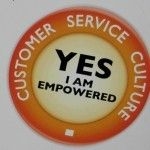It was a heady time.
Corporate logistics. We had 600+ stores, 600+ vendors, 5 DCs and hundreds of internal people making inventory flow from over 600 points on the map through our five distribution centers.
Change was constant. The market changed. Ownership changed. Leadership changed. Merchants changed. Marketing direction changed. Sourcing philosophy changed. Carriers changed. Transportation Management Systems changed. Warehouse Management systems changed. Picking methods changed. Vendors changed. In about a decade, the entire supply chain realm changed.
We shifted both strategic and tactical directions. Our systems and execution improved greatly, as the warehouses learned their new systems; our inventory accuracy approached the reasonable perfection inflection point. The new changes in Merchandising leadership increased our import from China volume increase 200%. The Inventory Management crew started to understand and then master their new IMS (Inventory Management System) platform; making a better job planning inventory and starting to figure out how to reduce lead times.
It was heady alright. We were in full form change mode.
In the middle of it all, I saw a presentation about a Vendor Compliance platform; a bolt-on SaaS platform with little up-front cost. We only had to share a percentage of the compliance fines we charged the vendors. This system intrigued me. I saw this as being a supply chain version of Archimedes Lever. This could be what we needed to make real supply chain change happen.
If you ever were tasked with making change happen within an organization, you know how hard the task is. Sometimes even the smallest of internal changes can rile up the troops. People get particular about how they like to do their jobs. Mess with the layout, or the process and not tell them in advance and they will hand you a headache. If something beyond company control changes, like a vendor changes to case markings, the gemba grumbles. There is an art, and a lot of hard work, to making internal change happen. You have to think, plan, communicate, beg, listen, plead, listen, repeat, report, encourage, the list goes on of the activities even the best of us change management artists have to do to get internal change to happen.
But what about making an external entity change, like getting a vendor to change into a supplier? Many won’t even try it. Companies attempt to improve the relationship, but it is really hard. In many cases the supply-demand relationship looks like the unhappy married couple, where the girl married the boy with the expectations of changing his behavior – and not getting anywhere. So many companies take a hard stance – without really thinking about how the organic supply chain processes are not helping.
This Compliance Management System (CMS) could be the long lever I was looking for to get the vendors to change, for them to agree to change the transport terms, improve fill rates, and ship on time. If we could get half of the vendors to change, to improve their performance in any one of those three areas, we could cut millions in operating costs and millions in inventory safety stock. Synchronizing our supply chain across the supply side could create millions in liberated working capital. Talk about a double bag of OCF!
That was when I became the “secret agent” of change. I knew what it meant to the company in dollars, millions of dollars. That may make the CFO happy. To make this all work, I had to figure out how to make this a great deal for lots of other people, like the buyers, the inventory managers, marketing reps, salespeople, and vendors. I had to figure out the WIFM for each of those groups.
In the end, I had to figure out a WIFM for over 200 people.
Change Management
To get really good at change management, you have to be making change happen all of the time. If you are making change happen all of the time, you are going to make mistakes, screw up, and sometimes make a colossal mess out of it. Hopefully the times you make a colossal mess happen early in your career, on something that was simply embarrassing and not life-threatening. You learn from making mistakes, both forced and unforced errors.
For over 30 years, I carried the role of being a change agent. Sometimes the ride was smooth. I was at fault a fair number of times, pushing change the wrong way, or sometimes pushing the wrong change. Hidden obstacles emerged after we started on the change journey, making us change plans and navigate around the problems. Sometimes people were the obstacles, and we changed their perspective with a good WIFM by making them a Godfather Offer to change their position. I got much better at leading change after decades of practice. As the joke goes, I got the t-shirts and I have the scars. And some of those scars can really tell a story.
That is what we share throughout this website. Most of what we teach here is change, focused on what to change with a little how thrown in. This section is different – as we are talking about how to change. Most of the articles are stories, think of them as illustrative case studies, told with a little entertainment value to help teach the lessons that we learned from the gemba.
Articles in This Series
Articles in This Series

Asking Questions?
Too often, managers think that simply inviting their employees to make comments about a plan is enough to get them to open up and contribute. If only it were that easy. The reality is different from the perception. If there is a high level of behavioral trust between the leader and the employees, then yes, people may feel comfortable contributing ideas. If that trust if missing or damaged, however, employees are much less likely to feel comfortable enough to make insightful comments. Read More
Glacial or Sudden Change?
“How hard can it be to change?” the client asked me about his project. The business process change this manager was leading had run into implementation problems … problems of the people variety. Read More
Self-Control Fatigue
Change can wear people out. When people are not in control of what is happening in the workplace, they wear out. Having survived multiple strategic changes in my corporate life — including leveraged buyouts, new presidents, new bosses, new programs, and new jobs — the one constant in all these changes was the energy needed to survive, and perhaps thrive, in the waves of change. Read More
Another Seven Methods of Disposing of Problems
In the previous article, I posted a list of Seven Ways to Resolve a Problem. That was a list of ways to resolve a problem, as in solving or not solving it. In this article, I have a list, found in old notes, of ways to dispose of a problem. Read More
The Camera That Captures Your Past, Future and Present\
It's a bit uncomfortable to put it that way, isn't it? The order is simply... off. It's with good reason we go our whole lives thinking of stories as beginning-middle-end; the arrow of time moves in but one direction. It's unnatural to tell stories any way but chronologically. Read More

Kinds of Problems
The voice caught my attention. I thought about it, and then said, “Yep. I got a bunch of problems. It's OK. I love problems!” Read More

Can You Control With Profit Punishment?
One can argue that regulation is needed to keep management from violating the social contract between the enterprise and society. Examples of how businesses in the past violated that social contract are often cited as justification for more regulation. Read More

Looking for a Few Good Customers? Take a Look at Yourself First
In these trying economic times, the natural tendency for a second- or third-generation, family-owned business would be to hunker down and just try to maintain the status quo. Read More

The Seven Ways to Resolve a Problem
Decades ago, while researching an academic paper, I discovered a small technical periodical that focused on computer science and data processing. Often the pages would contain little space fillers, just short quips that filled out the rest of the unused column. Read More

Empowered to Do What? Customer Service Culture: You've Got to Be Kidding
I recently took a trip to my local Home Depot® to pick up supplies for a few small improvement projects. Visiting the paint, plumbing, gardening and electrical departments I easily found everything I was shopping for, but along the way I picked up on some other items as well – my observations of Home Depot’s “Customer Service Culture.” Read More

The E and O of Change
If we turn our attention to the prime directive of business — make more money, today and tomorrow — we find a very simple reason for change. Businesses change to make more money, today and tomorrow. This prime directive is the economic argument for change in business. Read More


